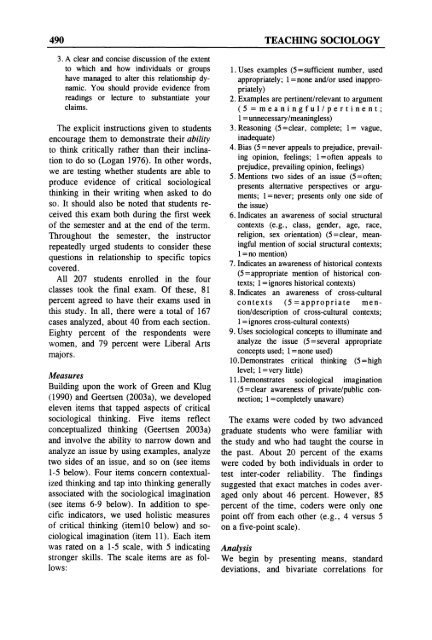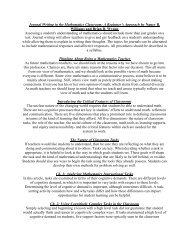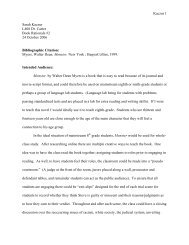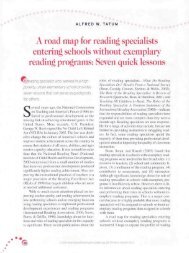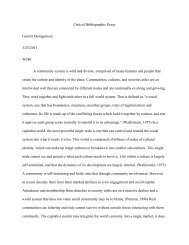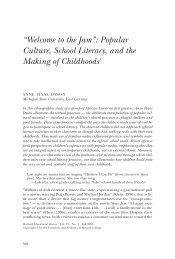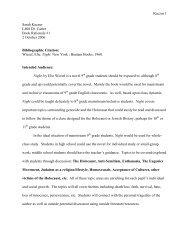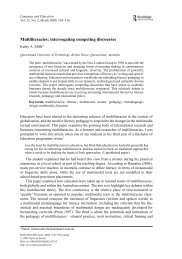Grauerholz 2003 Assessing critical thinking sociology.pdf - Oncourse
Grauerholz 2003 Assessing critical thinking sociology.pdf - Oncourse
Grauerholz 2003 Assessing critical thinking sociology.pdf - Oncourse
- No tags were found...
You also want an ePaper? Increase the reach of your titles
YUMPU automatically turns print PDFs into web optimized ePapers that Google loves.
490 TEACHING SOCIOLOGY3. A clear and concise discussion of the extentto which and how individuals or groupshave managed to alter this relationship dynamic.You should provide evidence fromreadings or lecture to substantiate yourclaims.The explicit instructions given to studentsencourage them to demonstrate their abilityto think <strong>critical</strong>ly rather than their inclinationto do so (Logan 1976). In other words,we are testing whether students are able toproduce evidence of <strong>critical</strong> sociological<strong>thinking</strong> in their writing when asked to doso. It should also be noted that students receivedthis exam both during the first weekof the semester and at the end of the term.Throughout the semester, the instructorrepeatedly urged students to consider thesequestions in relationship to specific topicscovered.All 207 students enrolled in the fourclasses took the final exam. Of these, 81percent agreed to have their exams used inthis study. In all, there were a total of 167cases analyzed, about 40 from each section.Eighty percent of the respondents werewomen, and 79 percent were Liberal Artsmajors.MeasuresBuilding upon the work of Green and Klug(1990) and Geertsen (<strong>2003</strong>a), we developedeleven items that tapped aspects of <strong>critical</strong>sociological <strong>thinking</strong>. Five items reflectconceptualized <strong>thinking</strong> (Geertsen <strong>2003</strong>a)and involve the ability to narrow down andanalyze an issue by using examples, analyzetwo sides of an issue, and so on (see items1-5 below). Four items concern contextualized<strong>thinking</strong> and tap into <strong>thinking</strong> generallyassociated with the sociological imagination(see items 6-9 below). In addition to specificindicators, we used holistic measuresof <strong>critical</strong> <strong>thinking</strong> (iteml0 below) and sociologicalimagination (item 11). Each itemwas rated on a 1-5 scale, with 5 indicatingstronger skills. The scale items are as follows:1. Uses examples (5= sufficient number, usedappropriately; 1= none and/or used inappropriately)2. Examples are pertinent/relevant to argument(5 =meaningful/pertinent;1 = unnecessary/meaningless)3. Reasoning (5=clear, complete; 1= vague,inadequate)4. Bias (5= never appeals to prejudice, prevailingopinion, feelings; 1l=often appeals toprejudice, prevailing opinion, feelings)5. Mentions two sides of an issue (5= often;presents alternative perspectives or arguments;1l=never; presents only one side ofthe issue)6. Indicates an awareness of social structuralcontexts (e.g., class, gender, age, race,religion, sex orientation) (5=clear, meaningfulmention of social structural contexts;1 =no mention)7. Indicates an awareness of historical contexts(5= appropriate mention of historical contexts;1 = ignores historical contexts)8. Indicates an awareness of cross-culturalcontexts (5 =appropriate mention/descriptionof cross-cultural contexts;1 = ignores cross-cultural contexts)9. Uses sociological concepts to illuminate andanalyze the issue (5= several appropriateconcepts used; 1l=none used)10.Demonstrates <strong>critical</strong> <strong>thinking</strong> (5=highlevel; 1l=very little)11. Demonstrates sociological imagination(5=clear awareness of private/publiconnection;1 =completely unaware)The exams were coded by two advancedgraduate students who were familiar withthe study and who had taught the course inthe past. About 20 percent of the examswere coded by both individuals in order totest inter-coder reliability. The findingssuggested that exact matches in codes averagedonly about 46 percent. However, 85percent of the time, coders were only onepoint off from each other (e.g., 4 versus 5on a five-point scale).AnalysisWe begin by presenting means, standarddeviations, and bivariate correlations for


